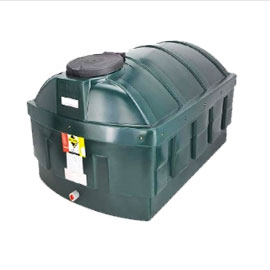- Home
- Home
- Heating Oil News
- Choosing A Fuel Tank, Part 2
Now in part 1 of this blog I focused on the general issues for choosing an oil tank, as this is a question that we often find customers asking about. Fundamental issues were covered including, single skinned or bunded oil tanks as well as fuel and size. These topics are all very important when considering an oil tank purchase, however there are also a variety of technical elements that need to be well thought out and planned before you buy your tank.
[fulltext] =>
Support and Building Regulations
It is of supreme importance for safety and environmental reasons that you provide an adequate base and support system for your oil tank. The base itself needs to hold support for the actual weight of the tank, and must be balanced as well as being non-combustible and imperforate. It must also be made form concrete or stone (paving slabs are okay) and be spacious enough to expand 300mm past every edge of the tank. Poorly supported fuel tanks can often cause oil leaks and spillages, which is why I urge you to take care when setting this up. Also it is mandatory for tank installations to act in accordance with Regional Building Regulations. If you are a resident of England or Wales then I strongly suggest contacting an OFTEC registered technician due to their authority to provide self certified work. They can also provide you with necessary annual tank inspections. To make contact with an OFTEC technician simply check the Heating Engineers section of any local phone directory.
Tank Location
There is a list of fire separation distances that are put in place for the protection of stored oil from potential heat sources. These distances are not to be ignored and currently stand as the following,
Tanks should be sited:
• 1.8m away from non-fire rated eaves of a building
• 1.8m away from a non-fire building or structure (e.g. garden sheds)
• 1.8m away from opening (such as doors and windows) in a fire rated building or structure (e.g.
brick built house/garage)
• 1.8m away from oil fired appliance flue terminals
• 760mm away from a non-fire rated boundary such as a wooden boundary fence
• 600mm away from screening (e.g. trellis and foliage that does not form part of the boundary)
All of these factors need to be looked into before buying your fuel tank as they can directly have effect on such things as the size, height, shape and type. Make sure that you get your measurements right or you could find yourself with a serious problem when you come to installing your tank.
Final Reminders
Well hopefully this information is of use, however please do not hesitate to give us a call if there’s anything you would like further advice or information on. Remember to comply by all Regional Building Regulations and to get in touch with an OFTEC registered technician who can provide a number of relevant services including, tank inspections, installations, commissions, as well as a barrel full of advice!
A full range of our oil storage tanks are available here and you can ask a question or get more advice here.
[state] => 1 [catid] => 9 [created] => 2015-07-29 13:25:12 [created_by] => 61 [created_by_alias] => [modified] => 2019-08-13 11:28:02 [modified_by] => 61 [checked_out] => [checked_out_time] => [publish_up] => 2015-07-29 13:25:12 [publish_down] => [images] => {"image_intro":"images\/oiltank.jpg","float_intro":"right","image_intro_alt":"Oil tank","image_intro_caption":"Always abide by the Regional Building Regulations when installing an Oil Tank","image_fulltext":"images\/oiltank.jpg","float_fulltext":"right","image_fulltext_alt":"Oil tank","image_fulltext_caption":""} [urls] => {"urla":false,"urlatext":"","targeta":"","urlb":false,"urlbtext":"","targetb":"","urlc":false,"urlctext":"","targetc":""} [attribs] => {"article_layout":"","show_title":"","link_titles":"","show_tags":"","show_intro":"","info_block_position":"","info_block_show_title":"","show_category":"","link_category":"","show_parent_category":"","link_parent_category":"","show_associations":"","show_author":"","link_author":"","show_create_date":"","show_modify_date":"","show_publish_date":"","show_item_navigation":"","show_icons":"","show_print_icon":"","show_email_icon":"","show_vote":"","show_hits":"","show_noauth":"","urls_position":"","alternative_readmore":"","article_page_title":"","show_publishing_options":"","show_article_options":"","show_urls_images_backend":"","show_urls_images_frontend":""} [version] => 10 [ordering] => [metakey] => oil tank regulations, oil tank regulations uk, oil tank location, oil tank location rules, oil tank location regulations, oftec rules and regulations. [metadesc] => Guidance for choosing a fuel tank with information on support and building rules and regulations, tank location and some final helpful reminders. [access] => 1 [hits] => 4453 [metadata] => Joomla\Registry\Registry Object ( [data:protected] => stdClass Object ( [robots] => [author] => [rights] => [xreference] => ) [initialized:protected] => 1 [separator:protected] => . ) [featured] => 0 [language] => * [featured_up] => [featured_down] => [category_title] => Heating Oil News [category_alias] => heating-oil-news [category_access] => 1 [category_language] => * [author] => tr10.support [parent_title] => ROOT [parent_id] => [parent_route] => [parent_alias] => root [parent_language] => * [rating] => [rating_count] => [params] => Joomla\Registry\Registry Object ( [data:protected] => stdClass Object ( [article_layout] => _:default [show_title] => 1 [link_titles] => 0 [show_intro] => 1 [info_block_position] => 0 [info_block_show_title] => 1 [show_category] => 0 [link_category] => 0 [show_parent_category] => 0 [link_parent_category] => 0 [show_associations] => 0 [flags] => 1 [show_author] => 0 [link_author] => 0 [show_create_date] => 0 [show_modify_date] => 0 [show_publish_date] => 0 [show_item_navigation] => 0 [show_vote] => 0 [show_readmore] => 1 [show_readmore_title] => 0 [readmore_limit] => 100 [show_tags] => 1 [show_icons] => 0 [show_print_icon] => 0 [show_email_icon] => 0 [show_hits] => 0 [record_hits] => 1 [show_noauth] => 0 [urls_position] => 0 [captcha] => [show_publishing_options] => 1 [show_article_options] => 1 [save_history] => 0 [history_limit] => 10 [show_urls_images_frontend] => 0 [show_urls_images_backend] => 1 [targeta] => 0 [targetb] => 0 [targetc] => 0 [float_intro] => left [float_fulltext] => left [category_layout] => _:default [show_category_heading_title_text] => 1 [show_category_title] => 0 [show_description] => 1 [show_description_image] => 0 [maxLevel] => 1 [show_empty_categories] => 0 [show_no_articles] => 1 [show_subcat_desc] => 1 [show_cat_num_articles] => 0 [show_cat_tags] => 1 [show_base_description] => 1 [maxLevelcat] => -1 [show_empty_categories_cat] => 0 [show_subcat_desc_cat] => 1 [show_cat_num_articles_cat] => 1 [num_leading_articles] => 0 [num_intro_articles] => 9 [num_columns] => 1 [num_links] => 0 [multi_column_order] => 0 [show_subcategory_content] => 0 [show_pagination_limit] => 1 [filter_field] => hide [show_headings] => 1 [list_show_date] => 0 [date_format] => [list_show_hits] => 1 [list_show_author] => 1 [list_show_votes] => 0 [list_show_ratings] => 0 [orderby_pri] => order [orderby_sec] => rdate [order_date] => created [show_pagination] => 1 [show_pagination_results] => 1 [show_featured] => show [show_feed_link] => 1 [feed_summary] => 0 [feed_show_readmore] => 0 [sef_advanced] => 1 [sef_ids] => 1 [custom_fields_enable] => 1 [show_page_heading] => 0 [layout_type] => blog [menu_text] => 1 [menu_show] => 1 [page_title] => Heating Oil News | Homefuels Direct [secure] => 0 [page_description] => National Heating Oil Delivery ✅ Get the best price for your home heating oil with an instant quote. Easy ordering | Fast & friendly service | UK-wide delivery [page_rights] => [robots] => [access-view] => 1 ) [initialized:protected] => 1 [separator:protected] => . ) [tagLayout] => Joomla\CMS\Layout\FileLayout Object ( [options:protected] => Joomla\Registry\Registry Object ( [data:protected] => stdClass Object ( [component] => com_content [client] => 0 ) [initialized:protected] => [separator:protected] => . ) [data:protected] => Array ( ) [debugMessages:protected] => Array ( ) [layoutId:protected] => joomla.content.tags [basePath:protected] => [fullPath:protected] => [includePaths:protected] => Array ( ) ) [slug] => 15:choosing-a-fuel-tank-part-2 [readmore_link] => /home/heating-oil-news/choosing-a-fuel-tank-part-2 [text] =>Now in part 1 of this blog I focused on the general issues for choosing an oil tank, as this is a question that we often find customers asking about. Fundamental issues were covered including, single skinned or bunded oil tanks as well as fuel and size. These topics are all very important when considering an oil tank purchase, however there are also a variety of technical elements that need to be well thought out and planned before you buy your tank.
Support and Building Regulations
It is of supreme importance for safety and environmental reasons that you provide an adequate base and support system for your oil tank. The base itself needs to hold support for the actual weight of the tank, and must be balanced as well as being non-combustible and imperforate. It must also be made form concrete or stone (paving slabs are okay) and be spacious enough to expand 300mm past every edge of the tank. Poorly supported fuel tanks can often cause oil leaks and spillages, which is why I urge you to take care when setting this up. Also it is mandatory for tank installations to act in accordance with Regional Building Regulations. If you are a resident of England or Wales then I strongly suggest contacting an OFTEC registered technician due to their authority to provide self certified work. They can also provide you with necessary annual tank inspections. To make contact with an OFTEC technician simply check the Heating Engineers section of any local phone directory.
Tank Location
There is a list of fire separation distances that are put in place for the protection of stored oil from potential heat sources. These distances are not to be ignored and currently stand as the following,
Tanks should be sited:
• 1.8m away from non-fire rated eaves of a building
• 1.8m away from a non-fire building or structure (e.g. garden sheds)
• 1.8m away from opening (such as doors and windows) in a fire rated building or structure (e.g.
brick built house/garage)
• 1.8m away from oil fired appliance flue terminals
• 760mm away from a non-fire rated boundary such as a wooden boundary fence
• 600mm away from screening (e.g. trellis and foliage that does not form part of the boundary)
All of these factors need to be looked into before buying your fuel tank as they can directly have effect on such things as the size, height, shape and type. Make sure that you get your measurements right or you could find yourself with a serious problem when you come to installing your tank.
Final Reminders
Well hopefully this information is of use, however please do not hesitate to give us a call if there’s anything you would like further advice or information on. Remember to comply by all Regional Building Regulations and to get in touch with an OFTEC registered technician who can provide a number of relevant services including, tank inspections, installations, commissions, as well as a barrel full of advice!
A full range of our oil storage tanks are available here and you can ask a question or get more advice here.
[tags] => Joomla\CMS\Helper\TagsHelper Object ( [tagsChanged:protected] => [replaceTags:protected] => [typeAlias] => [itemTags] => Array ( ) [tags] => [newTags] => [oldTags] => ) [jcfields] => Array ( [27] => stdClass Object ( [id] => 27 [title] => Extra Content [name] => extra-content [checked_out] => [checked_out_time] => [note] => [state] => 1 [access] => 1 [created_time] => 2023-04-06 10:06:58 [created_user_id] => 66295 [ordering] => 0 [language] => * [fieldparams] => Joomla\Registry\Registry Object ( [data:protected] => stdClass Object ( [buttons] => [width] => [height] => [filter] => raw ) [initialized:protected] => 1 [separator:protected] => . ) [params] => Joomla\Registry\Registry Object ( [data:protected] => stdClass Object ( [hint] => [class] => [label_class] => [show_on] => [render_class] => [value_render_class] => [showlabel] => 1 [label_render_class] => [display] => 2 [layout] => [display_readonly] => 2 ) [initialized:protected] => 1 [separator:protected] => . ) [type] => editor [default_value] => [context] => com_content.article [group_id] => 0 [label] => Extra Content [description] => [required] => 0 [only_use_in_subform] => 0 [language_title] => [language_image] => [editor] => [access_level] => Public [author_name] => [group_title] => [group_access] => [group_state] => [group_note] => [value] => [rawvalue] => ) ) [event] => stdClass Object ( [afterDisplayTitle] => [beforeDisplayContent] => [afterDisplayContent] => ) )Choosing A Fuel Tank, Part 2
Now in part 1 of this blog I focused on the general issues for choosing an oil tank, as this is a question that we often find customers asking about. Fundamental issues were covered including, single skinned or bunded oil tanks as well as fuel and size. These topics are all very important when considering an oil tank purchase, however there are also a variety of technical elements that need to be well thought out and planned before you buy your tank.
Warning: Undefined variable $articlectaText in /home/homefuels/public_html/templates/2019_HFD/html/com_content/article/default.php on line 50

The World Needs Cleaner Energy for Everyone

HomeFuels Direct is part of DCC Energy, of DCC plc.
